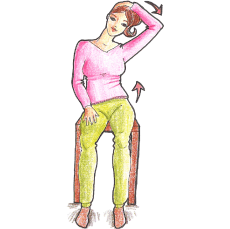Sitting on the chair

1. Bring the right hand on top of your head, tilting the head. Bring your right ear towards the right shoulder with his nose, eyes, face, facing forward. Be careful not to turn the head but to bend it to the right. If it can help you, imagine that someone holds firmly your nose and see how you organize yourself to make the movement. Feel that:
• The right ear is close to the right shoulder
• The right side of the ribs are closed
• The right buttock is lifted a little staying on the chair
• The weight gradually pass to the left hip
• The left side stretches and opens like an accordion
• Feel whether the movement encourages inhaling or exhaling
• Make sure that the movements are easy and harmonious reducing the amplitude

2. Repeat the movement on the right side.
Put one hand on the head and tilt it in order to approach the ear to the shoulder:
• Try to soften breast, hip, pelvis
• Involve the entire body so that the movement is not carried out only by the head
• As you exhale flex yourself

3. take the position.
Lift the right side by pressing lightly with the right foot
• Feel that while the right hip is raised a bit, ribs bend themselves approaching the basin
• The head tilts to the right
• The weight moves to the side

4. Repeat on the left side.
Tilting the head toward the left shoulder
• Feel like the left side is closed while the right side stretches
• Make small movements and use little power so that your chest and spine move sinuously
• Leave free the breathing

5. Sitting on the chair with right hand on the head, tilt your head to the right and simultaneously raise the right hip
• Switch the movement going from side to side
• Feel how a side stretches while the other one shortens
• Towards which direction do you prefer to go?
• What is the side you feel more flexible and relaxed?
• While performing the movements small, pleasant and harmonious feel how the spine tilts as a tree trunk ones to the right and ones to the left under the action of the wind
• Feel how the weight moves alternately from side to side

Now take a moment to rest...
• Feel if there is a difference between the right side and the left one
• Do you feel that your neck, shoulders, ribs, the lumbar region in the right side are more relaxed?
• How do you feel supported the pelvis on the right side?
• Do you think that the weight is distributed more on the right or on the left?
6. Repeat with the left hand on the head and bend it head from side to side

